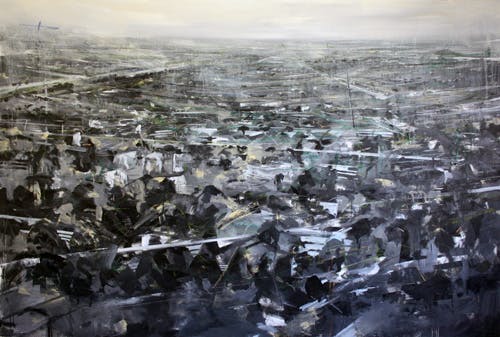Works Influenced by Agricultural Landscapes
Formative experiences working on farms in locales as diverse as Iowa and Italy have shaped Thomas Agran’s work as an artist. Wilmington College will host an exhibit of his agriculture-influenced paintings Jan. 15 through March 6 in Harcum Gallery.
An opening reception with the artist will be held Jan. 15 from 6 to 8 p.m. Normal gallery hours are weekdays, from 9 a.m. to 5 p.m., and by special appointment arranged by gallery curator Hal Shunk, professor of art.
Agran is the son of Wilmington College faculty members Edward Agran, professor of history, and Charlotte Fairlie, associate professor of English. Born in Stanford, Ky., he grew up in Wilmington and Cincinnati, graduating in 2005 from Madeira High School.
Agran studied fine art at Grinnell College (Iowa), where he graduated with honors with a Bachelor of Arts degree in studio art, and then completed his Master of Fine Arts in painting at Indiana University. He resides, works and gardens in Iowa City, Iowa.
Focusing on agriculture in the Midwest and Great Plains, Agran’s work examines industrialized agriculture’s impact on the landscape, as well as both “absurdities and eccentricities” of its practice.
“Our landscape’s total transformation through agriculture and the culture that has risen around it fascinates me,” he said, noting that his work features such seemingly divergent images as “large, loosely handled” landscapes and, conversely, more tightly designed images of livestock.
Agran adds that Midwestern agriculture is often viewed as either “seductively bucolic or disturbingly industrial.”
“In either case, it is a vast and brutally elegant landscape, embodying ponderous externalities of cost,” he said, adding that, in many instances, the environmental, political and social ramifications of the ways in which land is used are difficult to see, yet worthy of reflection.
“Through an aggressive handling of materials, my paintings attempt to depict our industrialized landscape using similar processes to how it is created,” he said.
“While observant of abuse of the land, I am also interested in the manipulation of our nostalgia for agriculture and intrigued by eccentricities and absurdities of its practice,” he said. “My livestock paintings, while birthed from a serious foundation, amuse me and provide levity in the studio."
As a resident of Iowa, Agran shares with his audiences a more current view of Midwestern rural life and landscapes from that of Iowa favorite son Grant Wood (1891-1942), whose iconic “American Gothic” and related works continue to resonate with many as a reflection of mid-America.
“A lot has changed in this part of the country since then,” he said, “and it excites me to work towards a more contemporary sense of regionalism.”
Agran’s work can be found in private, corporate and institutional collections, as well as the Cedar Rapids (Iowa) Museum of Art.

Harcum Gallery to Open 2015 with Exhibit by Thomas Agran
Art